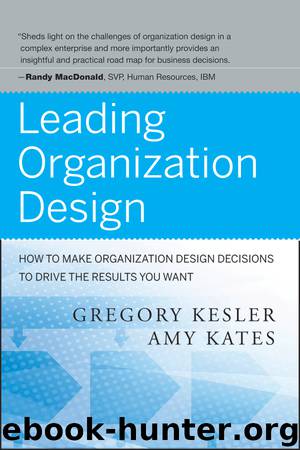Leading Organization Design: How to Make Organization Design Decisions to Drive the Results You Want by Gregory Kesler & Amy Kates

Author:Gregory Kesler & Amy Kates
Language: eng
Format: epub
Publisher: Jossey-Bass
Published: 2010-10-28T04:00:00+00:00
The “Problem with Corporate”
Today’s corporate-center functions often struggle to define the distinct value they add to the growth agenda for the business. In many companies, corporate staffs suffer identity crises, and the top talent is drawn to big jobs in the operating units rather than to roles in the center. For example, division presidents often love their own HR partners but rate the competence of the overall function consistently low, and are constantly battling to reduce allocated costs from the center. Conflicts over roles and decision rights become commonplace, staffers are frustrated with their ability to have impact, and successive rounds of cost reduction continue to reduce capability indiscriminately. This dynamic repeats itself between the corporate level and the divisions and from the division or regional level down to the local units.
Companies that make the most progress in designing effective finance, HR, and IT functions create tight focus on how and where work is generated. They view the functions not just as compliance or service entities but as important information conduits and horizontal integrators. The ability of the functions to bring the right information forward enables better business decision making (Boudreau and Ramstad, 2007).
These companies have taken up the challenge to design the function from “end to end.” This means examining all activity and resources in the function at the center, across geographic units, and across business units as a collective in order to reconsider the overall cost and impact the function has on the business. The challenge starts with visibility. In many organizations, it is difficult even to identify how many people are doing finance work around the world.
In end-to-end function design, the value framework is converted into a delivery model and then an organization structure. The “center” and the “field” are designed as one integrated capability, with separate but linked roles to play. The human resources organization is a good example to illustrate the benefits of an end-to-end view of function design, but this analysis applies to any support function. In the traditional approach, “global” responsibility is assigned to the center, which manages an overarching HR strategy and a well-defined set of corporate HR activities and resources for the greater interest of the enterprise. In this model, the regional and business HR teams are closely aligned with the business leaders. Their costs are budgeted by the businesses, and they have considerable leeway in practices and in staffing their own functions. In many companies, they customize corporate initiatives to fit local needs. This popular model is expected to create an effective “strategic business partner.” Business leaders with a competent partner are generally satisfied with their local support. However, the model misses the opportunity to leverage the function as an integrative device for the enterprise. Typically, one finds
Limited consistency in core HR processes, deliverables, and impact on the business
Wide variation in HR skills and talent
Higher total HR costs, due to proliferation of functional resources and often redundancy across units
Limited information and best practice sharing or talent movement across the operating
Download
This site does not store any files on its server. We only index and link to content provided by other sites. Please contact the content providers to delete copyright contents if any and email us, we'll remove relevant links or contents immediately.
Bad Blood by John Carreyrou(6274)
Rich Dad Poor Dad by Robert T. Kiyosaki(6174)
Principles: Life and Work by Ray Dalio(5957)
Playing to Win_ How Strategy Really Works by A.G. Lafley & Roger L. Martin(5493)
Management Strategies for the Cloud Revolution: How Cloud Computing Is Transforming Business and Why You Can't Afford to Be Left Behind by Charles Babcock(4438)
The Confidence Code by Katty Kay(4035)
Thinking in Bets by Annie Duke(3996)
American Kingpin by Nick Bilton(3507)
Delivering Happiness by Tony Hsieh(3280)
Project Animal Farm: An Accidental Journey into the Secret World of Farming and the Truth About Our Food by Sonia Faruqi(3016)
The Power of Habit by Charles Duhigg(2964)
Brotopia by Emily Chang(2892)
Mastering Bitcoin: Programming the Open Blockchain by Andreas M. Antonopoulos(2891)
The Tyranny of Metrics by Jerry Z. Muller(2846)
I Live in the Future & Here's How It Works by Nick Bilton(2844)
The Marketing Plan Handbook: Develop Big-Picture Marketing Plans for Pennies on the Dollar by Robert W. Bly(2792)
The Content Trap by Bharat Anand(2778)
Building a StoryBrand by Donald Miller(2754)
Applied Empathy by Michael Ventura(2749)
